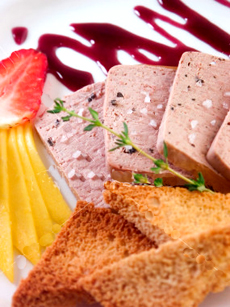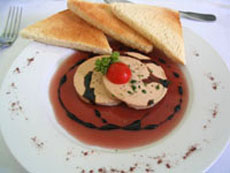Glossary Of The Different Charcuterie, Pâté & Saucisson Types
Page 1: Charcuterie Types
This is Page 1 of an 8-page article. Click on the red links below to visit other pages. This glossary is protected by copyright and cannot be reproduced in whole or part. You are welcome to link to it.
If you like pate and other types of charcuterie, you’ve come to the right place. As much as we love these delectable creations, there are so many different types, only an industry professional could keep them straight. That’s why we created this series of glossaries. Now you’ll know your Pâté de Campagne from your Pâté de Canard…and much more! And, all of these delicious products are made by one of the country’s best resources for authentic French charcuterie, Marcel et Henri (celebrating its 50th anniversary in 2009).
|
|

Pate served with toast points, sliced mango, strawberry, French sea salt and a drizzle of purple fig sauce. Photo by Kelly Cline | IST.
|
|
“Parlez-vous pâté?” ask Marcel et Henri? They certainly do: the company makes some of the best pates and other charcuterie we have tasted.
Charcutier Henri Lapuyade, founder of Marcel et Henri, started to make French pâtés in the United States in 1960. Beginning with a few recipes from his native France, he opened a small shop on San Francisco’s Russian Hill. Business thrived, his quality became renowned. In 1982 the French government awarded Henri the title of Chevalier de l’Ordre du Mérite Agricole for carrying on the great culinary tradition in the United States, and in 1997 he was promoted to Officier de l’Ordre du Mérite Agricole.
From that small shop on Russian Hill, Marcel et Henri pâtés have been enjoyed by many American Presidents, and are available to the rest of us at fine retailers nationwide.
The products read like a veritable glossary of great French charcuterie, so we’ve decided to write this review interweaving the products into a Pâté Glossary and a Sausage Glossary. First, we’ll start with an overview of the types of charcuterie.
|
|
Charcuterie Glossary: Types Of Charcuterie
Charcuterie (shar-KOO-tuh-REE) are fancy pork and related products made by a charcutier (shar-koo-tee-AIR), a fancy pork butcher. Originally, the art of charcuterie was used to preserve meat in the Middle Ages. The art continues in France as a hallmark of fine cuisine. While many charcuterie products contain only pork as their meat base, just as often the pork is combined with other meats, fowl or game. Modern charcuterie has expanded to include items with no pork at all—products made only of poultry, venison, vegetables or fish. The following products are common offerings of a charcutier:
|
|

|
- Boudin (boo-DAHN). The French word for pudding also doubles as the word for meat sausage, and, generically, any sausage-shaped mixture. Boudin blanc (boo-DAHN BLAHN), or white sausage, is a white sausage made of of veal, chicken, or pork. Boudin noir (boo-DAHN NWA), or red sausage, is pork blood sausage.
-
Fromage de Tête. Not a cheese, but a terrine of meat from the head of a calf or pig (sometimes a sheep or cow) that would not otherwise be considered appealing. Originally it was made entirely from the meaty parts of the head, but now can include meat from the feet, tongue, and heart. It is usually eaten cold or at room temperature as a luncheon meat.
- Galantine (gah-la-TEEN). A preparation of boned meat or whole poultry that is stuffed or rolled, cooked, then glazed with gelatin and served cold. Unlike a pâté, the meat is not ground, and it is not spreadable. Galantines are most often served as a first course.
- Pâté (pah-TAY). Pâté is the French word for paste, indicating elegant, well- seasoned ground meat, fish or vegetable preparations with a paste consistency. Pâtés are made in various spreadable textures and are served hot or cold as an hors d’oeuvre or a first course. They can be wrapped in fat or pastry. Technically, those wrapped in pastry should be called pâté, and those made in a fat-lined mold should be called terrine (see below). Pâtés are served cold, usually on toast. They are cooked one of two ways, either “pâté en croûte” (in crust) or “en terrine” (in a pork fat-lined container). Pâtés are probably the world’s most adaptable culinary form and may be served as simply or as elegantly as suits the mood and the occasion.
Photo of D’Artagnan duck pâté. Read our review.
- Mousse (MOOSE). A mousse is light, airy mixture usually containing eggs and cream, that can be sweet or savory. While savory mousses can have pudding-like consistencies just like chocolate mousse, a greater proportion of meat, fish or vegetable, creates a solid-form mousse. It is much lighter and spongier in texture than a pâté, and therefore more spreadable or malleable for hors d’oevres.
- Poitrine (pwah-TREEN). Poitrine is a breast of meat or poultry, but when the word is modified, it refers to bacon. Poitrine demi-sel is an unsmoked slab bacon; poitrine fumée is smoked slab bacon; poitrine roulée is rolled bacon.
- Rillettes (ree-YET). A highly spiced spread of meat or poultry first cooked in seasoned fat and then minced or pounded into a paste, and served as an appetizer with crackers or bread. Classic French rillettes are pork or rillettes d’oie, goose; but the spread can also be made with duck, fish or rabbit. After the rillettes are made, they are commonly placed in a ramekin and sealed with a thin layer of fat.
- Saucisse (so-CEASE). A small, fresh sausage. Variations include saucisse chaude, warm sausage; saucisse de Francfort, a hot dog; saucisse de Strasbourg, a redskinned hot dog; and saucisse de Toulouse, a mild country-style pork sausage.
- Saucisson (so-see-SEWN). A large air-dried sausage, such as salami, eaten sliced as a cold cut. When eaten fresh and warm, it is called saucisson chaud, or hot sausage. Variations include saucisson à l’ail, garlic sausage, usually served warm; saucisson d’Arles, a dried salami-style sausage of pork, beef and seasonings from Arles, in Provence; saucisson de campagne, any country-style sausage; saucisson de Lyon, air-dried pork sausage, flavored with garlic and pepper and studded with chunks of pork fat; saucisson de Morteau, plump smoked pork sausage that takes its name from the town of Morteau in the Jura (it is distinctive because a wooden peg is tied in the sausage casing on one end and it is traditionally the sausage eaten at Christmas, hence it it also called Jésus de Morteau); saucisson en croûte, sausage cooked in a pastry crust; and saucisson sec, any dried sausage, or salami.
- Terrine (tuh-REEN). A terrine is an earthenware dish named after the French word terre, meaning “earth.” It denotes that the dish has been baked in an dish. Traditionally, pâté baked in pastry were made in long, loaf-shaped earthenware terrines. Today, metal forms with releasable sides are often used for ease in removing the pate. See also Pâté.
Continue To Page 2: Different Types Of Pâté
Go To The Article Index Above
|

